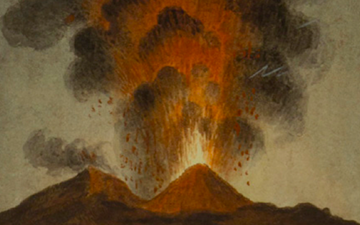A volcano is a rupture on the crust of a planetary-mass object, such as Earth, that allows hot lava, volcanic ash, and gases to escape from a magma chamber below the surface.
Earth’s volcanoes occur because its crust is broken into 17 major, rigid tectonic plates that float on a hotter, softer layer in its mantle.[1] Therefore, on Earth, volcanoes are generally found where tectonic plates arediverging or converging. For example, a mid-oceanic ridge, such as the Mid-Atlantic Ridge, has volcanoes caused by divergent tectonic plates pulling apart; the Pacific Ring of Fire has volcanoes caused byconvergent tectonic plates coming together. Volcanoes can also form where there is stretching and thinning of the crust’s interior plates, e.g., in the East African Rift and the Wells Gray-Clearwater volcanic field and Rio Grande Rift in North America. This type of volcanism falls under the umbrella of “plate hypothesis” volcanism.[2] Volcanism away from plate boundaries has also been explained as mantle plumes. These so-called “hotspots“, for example Hawaii, are postulated to arise from upwelling diapirs with magma from thecore–mantle boundary, 3,000 km deep in the Earth. Volcanoes are usually not created where two tectonic plates slide past one another.
Erupting volcanoes can pose many hazards, not only in the immediate vicinity of the eruption. One such hazard is that volcanic ash can be a threat to aircraft, in particular those with jet engines where ash particles can be melted by the high operating temperature; the melted particles then adhere to the turbine blades and alter their shape, disrupting the operation of the turbine. Large eruptions can affect temperature as ash and droplets of sulfuric acid obscure the sun and cool the Earth’s lower atmosphere (or troposphere); however, they also absorb heat radiated up from the Earth, thereby warming the upper atmosphere (or stratosphere). Historically, so-called volcanic winters have caused catastrophic famines.
(From Wikipedia, February 2015)


